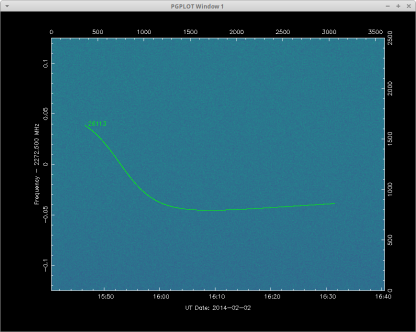When NASA lost contact with IMAGE, the Imager for Magnetopause-to-Aurora Global Exploration probe on December 18, 2005, it had hoped that the satellite would reboot when its batteries would drain during long eclipses in the Earth’s shadow. The Failure Review Board attributed the loss of contact to a failure of the power controller supplying power to the radio transponder, but surmised that the October 2007 eclipse season could possibly reset the power controller, allowing contact to be reestablished. The 2007 eclipse season passed but unfortunately NASA was unable to re-contact IMAGE. Scott Tilley’s discovery that the IMAGE satellite had returned from the dead showed that the a reset of the power controller had occurred some time after October 2007, and that IMAGE was waiting for someone to listen. So, when did the power controller reset?
Both Scott and myself perform occasional scans of the 2.2 to 2.3GHz part of the S-band spectrum where many satellites transmit their TT&C (telemetry, tracking and command) beacons. If IMAGE was transmitting during one of these scans, and was above our horizon, we would likely have picked up its signals.
The earliest scans of the band where IMAGE transmits its 2272.5MHz carrier signals were performed in January and February 2014 from my station in the Netherlands. During those months, the highly eccentric orbit of IMAGE was oriented such that the 1600 km perigee was at high latitudes of 86° North, meaning that, even though passes of the satellite would be short, they would be at close range. For example, the evening pass of January 2nd, 2014 had a minimal distance of 2500 km for my location in the Netherlands. Unfortunately, no signals from IMAGE were received during any of the passes in January and February of 2014. The plots below show the predicted Doppler curve shapes as green lines, based on JSpOC orbital elements from those dates.
Coverage of the 2272.5MHz band was spotty after that, and the first long scan of this part of the band was at the end of October 2016. During the 6.5 day scan, the 2272.5MHz carrier signal of IMAGE was detected on all passes where it rose sufficiently high above the horizon. At the time, the orbit had precessed to place perigee at 28° South latitude, meaning it would be nearer to apogee and more distant when visible from Northern Europe. Despite the larger distance, the signals were strong, as shown by the detections in these spectrograms.
The extracted Doppler frequencies matched JSpOC orbit predictions perfectly, as shown in the plot below, where red dots are the measurements, and the red and gray track the predictions. The white points in the top right circle show sky locations.
Since then, the 2272.5MHz carrier signal of IMAGE was detected by Scott in May 2017, and then again in January 2018. It was only then that Scott noticed the +1.7 and -1.7MHz sidebands, denoting it was sending data, and realized that IMAGE had been declared failed back in 2005.
So sometime between January/February 2014 and the end of October 2016, the batteries aboard IMAGE drained sufficiently to force a reset of the power controller. It is interesting that during that period the orbit of IMAGE was such that it did not experience deep eclipses in the Earth’s shadow. The plot below shows the eclipse lengths IMAGE experienced during its launch.
After the October 2007 eclipse season, the deepest eclipses occurred in May 2012 and again in December 2016, with the power controller resetting between these deep eclipse seasons. Most likely the battery efficiency degraded such over the IMAGE lifetime that during the less deep eclipses the battery drained sufficiently to lead to the reset and bring the transmitter aboard IMAGE back to life. It’s now up to NASA to re-establish contact with the probe and determine if IMAGE can provide scientific measurements 13 years after the mission was declared lost.










Fascinating, enjoyed reading it !
LikeLike
Thanks for explaining in detail. I also think this is fascinating and I hope you get all the credit you deserve!
LikeLiked by 1 person
Great write up, thanks! Just wondering, why the shorter duration eclipses are shown wider (along the year axis) in the graph?
LikeLike
The length of the eclipse is longer when the apogee of the orbit, the point furthest from the Earth, falls in the Earth’s shadow. This is because at apogee the satellite is moving slower so will spend a longer time in the shadow. The opposite is true when the perigee is in the shadow, where the satellite moves faster. Because the Earth moves around the Sun, and because the orbital plane rotates (precesses), the apogee or perigee will move through the shadow as a function of time. At apogee, the shadow of the Earth is smaller, so the rotation of the plane means the eclipse season is shorter, while at perigee the Earth’s shadow will cover more of the orbit, and it will take longer for the perigee to move through the shadow. I hope that explains it.
LikeLike